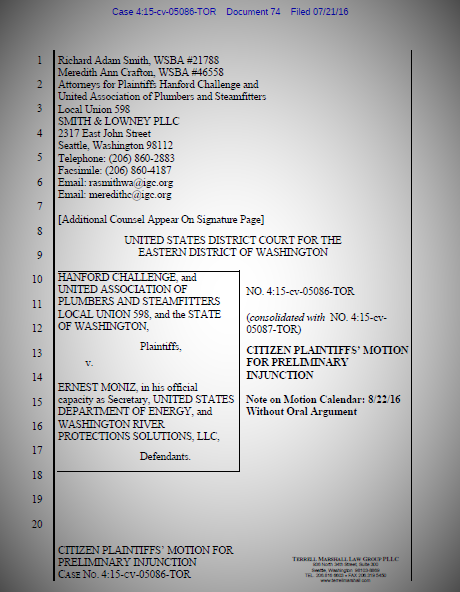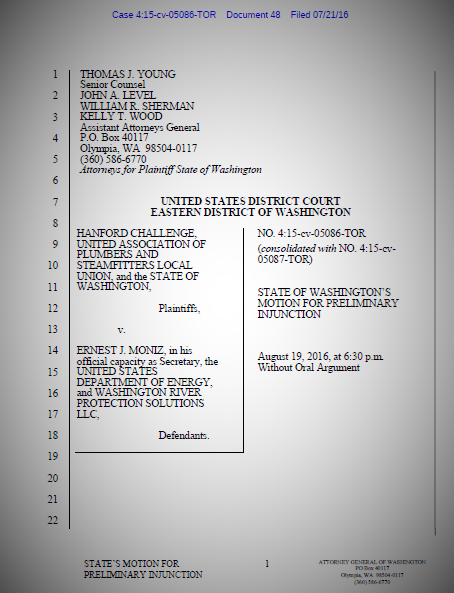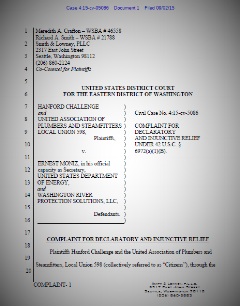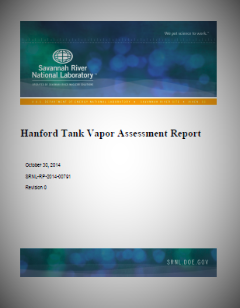Chemical Vapor Reports and Legal Filings
FOR more REPORTS & LEGAL FILINGS, CLICK HERE.
Chemical Vapors 101
At least 120 Workers were exposed to chemical vapors since Jan 2015, 73 of which occurred In APRIL and May 2016.
Over 1,800 chemicals have been documented in the vapors contained within Hanford's tank headspaces, which escape from the tanks through various pathways.
According to tank farm contractor documents, at least 120 Hanford workers in and around the tank farms were exposed to toxic vapors since January 2015.
Seventy-three (73) workers experiencing a vapor exposure at Hanford in April and May 2016. Some of these individuals are still experiencing negative health effects from exposures.
Workers exposed to toxic vapors have suffered serious long-term health effects including brain damage, lung diseases, nervous system disorders, and cancer. Short-term health effects have included nosebleeds, profuse sweating, persistent headaches, tearing eyes, burning skin and lungs, coughing, sore throats, eye problems, dizziness, nausea, memory loss, difficulty breathing, and increased heart rates.
Some workers are on long-term disability resulting from chemical vapor exposure at Hanford, with illnesses such as toxic encephalopathy, neurological damage, nerve damage, and lung disease. Others are still fighting for their claims to be recognized. A 1997 Pacific Northwest National Laboratory study found that cancer risks from exposure to tank farm vapors carried a fatal cancer risk as high as 1 in 10.
CHEMICAL VAPOR EXPOSURES AT HANFORD HAVE BEEN ONGOING SINCE 1980.
The vapor exposure controversy is historical. In the early 1990's, numerous oversight investigations were conducted by the U.S. Department of Energy, Congress, and the Inspector General after 16 exposure incidents took place over a 4.5 year period. The resulting reports found gross mismanagement and potentially criminal activity in failing to protect workers from known hazards.
In 2006, CH2M Hill (a Hanford contractor) issued a report titled, Industrial Hygiene Chemical Vapor Technical Basis. Hanford Challenge reviewed this report and raised several concerns. Hanford Challenge and CH2M Hill, both members of the Hanford Concerns Council (HCC), brought these concerns forward for an independent review that resulted in a 2008 report. As a result, a key finding exposed doubt about the credibility of vapor sampling data and concluded that the protective measures being used were not conservative enough to protect workers.
In 2014, in response to dozens of toxic vapor exposures resulting in medical symptoms and illnesses, Hanford commissioned an expert panel, led by Savannah River National Labs. That report's first "key conclusion" was that "the body of testimony and data examined by the team strongly suggests a causal link between chemical vapors from Hanford waste tanks and subsequent adverse health effects, particularly upper respiratory irritation, experienced by many Hanford workers." (TVAT Report, p. 15) TVAT found those worker exposures to be "dramatic and essentially instantaneous events" that were consistent only with acute exposure to vapors.
HANFORD CHALLENGE legal Action IS Working to BREAK THE VAPOR EXPOSURE CYCLE.
Hanford has a complicated history of vapor exposures, which typically follow this pattern: 1) vapor exposures occur at Hanford, 2) media attention and advocacy efforts follow, 3) published reports advocate for more worker protections, 4) some worker protections are put in place, 5) the public begins to forget about exposures, and 6) worker protections are reduced, resulting in new exposures. Hanford Challenge is tired of seeing this cycle repeat itself and is working to break this cycle once and for all, by holding the Department of Energy and its contractors accountable.
Hanford Challenge and Local 598 filed suit, in addition to a separate suit from the Washington Attorney General's Office, to bring an end to this cycle and protect workers now and in the future.
Hanford Challenge and UA Local 598 are represented by Smith & Lowney, LLC (Seattle), Public Justice (Washington DC) and Terrell Marshall Law Group, PLLC (Seattle).
Hanford Challenge is seeking the following remedies through its legal action:
require the use of supplied air (SCBA) for all workers inside the fences at the Hanford tank farms;
post a 200-foot vapor control zone requiring supplied air use during waste-disturbing activities;
install and deploy monitoring and alarming technologies on tanks; and
medical monitoring for workers exposed to toxic vapors.
Chemical Vapors: Frequently Asked Questions
WHAT ARE TOXIC CHEMICAL VAPORS?
There are many ways to describe toxic chemical vapors. Chemical vapors can include gases, fumes, and particulates. A chemical that is either solid or liquid when at normal room temperature and at normal pressure may turn into a vapor when heated sufficiently, or when the pressure is increased.
HOW DO WORKERS COME INTO CONTACT WITH TANK VAPORS?
There are many pathways in which workers may come into contact with tank vapors. The toxic vapors are in the headspace of the tanks and seep out during atmospheric conditions such as temperature and pressure inversion; during any type of waste disturbing activity such as pumping waste from leaking tanks; when inserting cameras or equipment into tanks; and other times through pipes, vents, filters or anywhere pressure can build and vapors can be released. Tanks must vent to the atmosphere to prevent pressure buildup and possible explosion or tank rupture.
WHAT CHEMICALS ARE IN HANFORD'S TANK HEADSPACES?
Over 1,800 chemicals have been documented in the vapors in Hanford tank headspaces. The toxic chemicals found in the tanks, many of which are recognized carcinogens; include ammonia, nitrous oxide, mercury, hydrocarbons, alcohols, ketones, aldehydes, furans, phthalates, nitriles, amines, and nitrosamines. Many more toxic vapors are known to be in the tanks and have been measured in the tank headspace at concentrations well above occupational exposure limits. Additional chemicals potentially venting from the tanks include dimethyl mercury, benzene, carbon tetrachloride, and n-nitrosodimethylamine (NDMA).
WHAT ARE THE POSSIBLE HEALTH EFFECTS OF EXPOSURE TO TANK VAPORS?
Workers who have been exposed to tank vapors have suffered numerous acute and long-term health effects. These include nosebleeds, metallic taste in the mouth, headaches, coughing, sore throats, nausea, and increased heart rates. Workers have developed chronic obstructive pulmonary disease, decrease in lung capacity, toxic encephalopathy, and cancer as a result of exposure to tank vapors. Some have ended up on long term disability after an exposure.
WHAT STUDIES HAVE BEEN DONE INTO TANK VAPORS AT HANFORD?
A number of studies on tank vapors at the Hanford Site have been conducted, included the 2003 Government Accountability Project report "Knowing Endangerment: Worker Exposure to Toxic Vapors at the Hanford Tank Farms." The most recent report is the October 2014 Savannah River National Laboratory's Hanford Tank Vapor Assessment Report (commonly referred to as the "TVAT Report"). One conclusion of this report matches those of earlier reports:
The ongoing emission of tank vapors, which contain a mixture of toxic chemicals, is inconsistent with the provision of a safe and healthful workplace free from recognized hazards.... Management must acknowledge the health risk associated with episodic releases of tank vapors. While the ability to measure and document exposures may currently be inadequate, workers are nonetheless being affected by vapors on the tank farms. Acceptance of this observation should be communicated to all internal and external stakeholders.
How Are CHemical VApors Monitored?
Vapors at Hanford are monitored by Industrial Hygiene Technicians. They perform real-time monitoring for ammonia, nitrous oxide, and total organic compounds. In addition, Hanford IH techs will occasionally monitor for mercury. Hanford also collects area samples and personal samples to analyze in a laboratory. Unfortunately, Hanford's monitoring of vapors is more notable for what it misses. Real-time monitoring does not occur for most of the 1,800 chemicals detected in the tank headspaces, including known cancer-causing chemicals. For the limited monitoring that does occur, it is not designed to capture high-concentration episodic releases in the breathing zone of workers, according to Hanford's own experts. Monitoring is not protective of workers.
What Protections are Available to Workers?
The only proven way to protect workers from exposure to chemical vapors, is to use a separate supply of air, known as SCBA (Separate Containerized Breathing Apparatus), also commonly referred to as "supplied air." Since workers were put on supplied air in August 2016, there have been no reports of exposures in the tank farms. This is consistent with past uses of SCBA over the past 25 years at Hanford - when SCBA is required, no one suffers from chemical vapor exposure.
WHAT RESOURCES ARE AVAILABLE FOR WORKERS WHO HAVE SUFFERED ADVERSE HEALTH EFFECTS AFTER A CHEMICAL VAPOR EXPOSURE?
One of the biggest challenges following exposure is finding knowledgeable medical care, and navigating worker compensation. Hanford Challenge frequently updates its list of referrals based on feedback from workers. If you, or someone you know is in need of resources, email info@hanfordchallenge.org with questions and concerns, or call 206-292-2850.
Chemical Vapors in the News
HANFORD CHALLENGE PRESS RELEASES/ADVISORIES
AG, Hanford Challenge and UA Local 598 ask court to order immediate worker protections at Hanford | July 21, 2016.
Hanford Challenge Response to DOE Press Release on Vapors | June 28, 2016.
Town Hall: It's Your Turn to Speak Up | June 27, 2016.
Hanford Workers File Federal Lawsuit Against Department of Energy and Contractor Over Toxic Vapors | September 2, 2015.
Union and Public Interest Advocates Serve Notice of Intent to Sue, Plan to Seek Order to Protect Workers | November 20, 2014.
Report: Worker Exposures and health Effects Resulting from Toxic Vapor Exposures Casually Linked; Hanford's Program Not Protective of Workers | October 30, 2014.
NEWS COVERAGE
DOE asks judge to dismiss Hanford chemical vapor lawsuit | Tri-City Herald, August 24, 2016.
Legal papers depict Hanford managers eager to cut back on safety | King 5, August 18, 2016.
Energy Secretary: Communication At Hanford Tank Farms Needs Improvement | Northwest News Network, August 17, 2016.
2 Hanford workers checked for vapor exposures | Tri-City Herald, August 3, 2016.
Legal action over Hanford safety heats up with judge's ruling | KING 5, August 2, 2016.
Statement from AG Ferguson regarding Hanford motion | Washington State Office of the Attorney General, August 2, 2016.
National Institute of Safety and Health visits Hanford | KVEW TV, July 25, 2016.
Safety equipment shortage sends Hanford workers home | Tri-City Herald, July 25, 2016.
AG, Hanford Challenge and UA Local 598 ask court to order immediate worker protections at Hanford | Office of the Attorney General, July 21, 2016.
AG files emergency action to force end to Hanford safety 'crisis' | King 5, July 21, 2016.
More workers report possible vapor exposure at nuke site | CBS News, July 13, 2016.
Workers at some Hanford tanks stop in dispute over vapors | Associated Press, July 11, 2016.
HAMTC Letter to WRPS RE: Tank Farm Vapors and Worker Safety | July 11, 2016.
Hanford nuclear contractor makes offer to cut vapor exposure | The Washington Times, July 8, 2016.
Hanford contractor counters on union chemical vapor demands | Tri-City Herald, July 7, 2016.
State AG reacts to Hanford safety: 'that pi**es me off' | KING 5, June 30, 2016.
Hanford workers and others gather to talk about health issues at town hall | KVEW, June 29, 2016.
Feds will review Hanford response to toxic vapors | Oregon Live, June 22, 2016.
Federal safety agency to evaluate Hanford chemical vapor issue | Tri-City Herald, June 22, 2016.
Hanford tank farm contractor says it is keeping workers safe | Tri-City Herald, June 21, 2016.
Workers wants answers about Hanford tank farm vapors | KONA, June 21, 2016.
HAMTC Letter to DOE and WRPS RE: Tank Farm Vapors and Worker Safety | June 20, 2016.
Hanford union group issues demands for chemical vapor protection | Tri-City Herald, June 20, 2016.
52 Workers at Washington Nuke Facility Checked for Vapor Exposure | Insurance Journal, June 17, 2016.
Hanford continues to mislead workers about toxic vapors | King 5, June 8, 2016.
Hanford launches website with chemical vapor monitoring data | Tri-City Herald, June 6, 2016.
Mobile lab to detect Hanford chemical vapors being tested | Tri-City Herald, May 22, 2016.
New Complaints of Exposures Emerge at Hanford Site | The Wall Street Journal, May 21, 2016.
Officials say two more workers at the Hanford Nuclear Reservation have received medical evaluations after they reported smelling vapors at the former nuclear weapons production site | Daily Journal, May 20, 2016.
Hanford vapor exposures hits record high -- Part 1 | KGW, May 20, 2016.
More Hanford workers reported smelling odors near TX tank farm | KEPR, May 10, 2016.
More Hanford workers report exposure to tank-farm vapors | The Seattle Times, May 5, 2016.
Record number of Hanford workers sickened by toxic vapors | King 5, May 5, 2016.
Total of 42 Hanford workers evaluated for chemical exposure | AP, May 5, 2016.
Nuclear waste leak continues at ‘America’s Fukushima’; 33 left ill by radioactive fumes | Weather Channel, May 4, 2016.
6 more workers sickened by radioactive fumes at Hanford nuclear site | RT, May 4, 2016.
Washington: 6 workers evaluated for vapor exposure at Hanford Nuclear Site | Democracy Now!, May 4, 2016.
State AG considers legal options to protect Hanford workers | Tri-City Herald, May 3, 2016.
3 more Hanford workers report vapor exposure | King 5, May 3, 2016.
Hanford’s leaky nuke tanks and sick workers, a never-ending saga | The Investigative Fund, May 2, 2016.
11 Hanford workers sick Thurs. from vapors | King 5, April 29, 2016.
Letter: Hanford workers were not always told the level of exposure | Tri-City Herald, February 17, 2016.
Washington state sues feds over safety of Hanford nuclear waste tanks; vapors sicken workers | Fox, September 2, 2015.
Washington state sues U.S. over toxic vapors at WWII-era Hanford nuclear waste site | Japan Times, September 2, 2015.
Hanford workers file lawsuit against U.S. Department of Energy and contractor over toxic vapors | NBC, September 2, 2015.
Murray, Cantwell call for Hanford worker protection | The Tri-City Herald, November 21, 2014.
Union, watchdog groups to sue over worker safety at Hanford | King5 News, November 20, 2014.

















